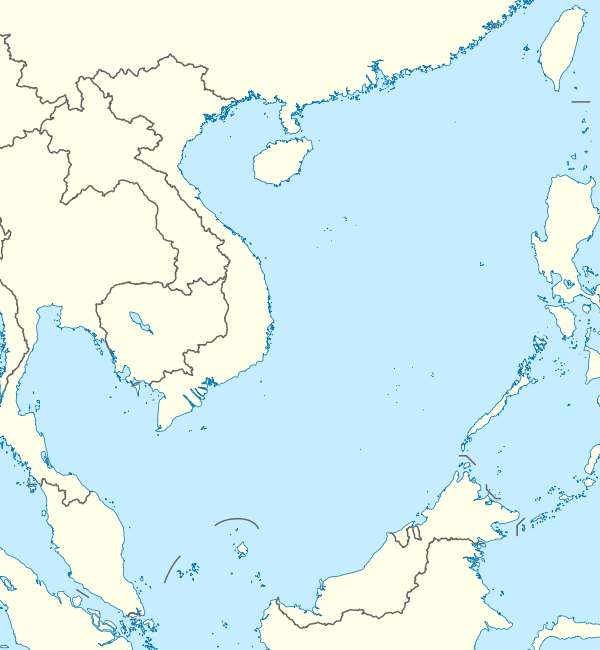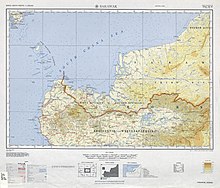James Shoal
James Shoal[1][5] is an underwater shoal (bank) in the South China Sea, with a depth of 22 metres (72 ft) below the surface of the sea,[1][6] located about 45 nautical miles (83 km; 52 mi) off the Borneo coast of Malaysia. It is claimed by Malaysia, the People's Republic of China, and the Republic of China (Taiwan). The shoal and its surrounds are administered by Malaysia.
| Disputed shoal Other names: Beting Serupai Zēngmǔ Ànshā (曾母暗沙) | |
|---|---|
| Geography | |
 | |
| Location | South China Sea |
| Coordinates | 03°58′26″N 112°20′56″E |
| Total islands | 0[1] |
| Administered by | |
| Malaysia[2] | |
| State | Sarawak |
| Claimed by | |
| People's Republic of China | |
| Prefecture-level city Province | Sansha[3] Hainan |
| Republic of China (Taiwan)[4] | |
Name
James Shoal is also called Beting Serupai[7] (Malaysia) and Zengmu Reef[8] / Zengmu Shoal[4] / Tseng-mu An-sha[5] (Chinese: 曾母暗沙[9]; pinyin: Zēngmǔ Ànshā; lit.: 'James submerged sandbank') (China and Taiwan).
History
James Shoal, along with its two nearby features, Parsons’ Shoal (Betting Tugau, 八仙暗沙, 9.35 km due south) and Lydie Shoal (Betting Mukah, 立地暗沙, 27.94 km west-southwest), were recognised by British surveyors in the early 19th Century via many of its surveys. James Shoal first appeared on the British Admiralty Chart in the 1870s. In 1933 a government committee of the Republic of China gave Chinese names to many features in the South China Sea. These were mainly translations or transliterations of the names on the British charts.[10] The name 'James' was transliterated as Zeng Mu (the letters 'J' and 'M'). 'Shoal' was translated as 'Tan' - meaning sandbank. It appears the Chinese committee wrongly thought that James Shoal was an island. In 1947 the RoC changed the name to 'Ansha' (暗沙)[11] - meaning 'shoal' or 'reef'.
Location

_(cropped).jpg)
Lying about 45 nautical miles (83 km; 52 mi) northwest of Bintulu, Malaysia on the Continental shelf of Borneo, the shoal is 80 kilometres (50 mi) from the Malaysian coast and about 1,800 kilometres (1,100 mi) from the Chinese mainland. Geographically, it sits south of the Spratly Islands, but is sometimes grouped with them as part of international disputes over sovereignty in the South China Sea.
The shoal is embedded in the continental shelf of Malaysia and well within its 200 nautical mile EEZ.[12]
Nearby shoals are Parsons' Shoal and Lydie Shoal,[2] and the Luconia Shoals, the latter 97 to 223 km to the north.
Territorial dispute
Malaysia's claim
Malaysia's claim on the shoal is based on the continental shelf principle, on the basis that Malaysia is the only country whose continental shelf covers James Shoal. International law defines continental shelf as a natural extension of a country’s landmass to a distance of 200 nautical miles (maximum 350 nautical miles). Drawn from the mainland or any of its islands in the South China Sea, the continental shelf of China is well short of James Shoal. Similarly, James Shoal is also not part of the extended continental shelf of Vietnam, the Philippines or Republic of China (Taiwan).[2]
In May 2009, Vietnam and Malaysia put up a Joint submission on the Extended Continental Shelf to the UN Committee on the Limit of Continental Shelf (CLCS) whereby Vietnam acknowledged that James Shoal is not part of its extended continental shelf.[12][2]
James Shoal is 500 nautical miles (930 km; 580 mi) from Thitu Island (Pagasa) in the Spratlys that the Philippines has occupied since 1971, and more than 400 nautical miles (740 km; 460 mi) from Itu Aba, an island that Republic of China (Taiwan) has occupied since 1956. It is also outside Brunei's extended maritime zone which the 2009 Letter of Exchange that Brunei has with Malaysia attests to. In 1969, Malaysia and Indonesia signed a Treaty on the continental shelf, off Tanjung Datu, Sarawak, which has placed James Shoal on the Malaysian side.[2]
Malaysian jurisdiction
Malaysia has also effectively asserted its jurisdiction over its continental shelf including the areas in and around James Shoal, Parson's Shoal and the Lydie Shoal. The activities of the Malaysian authorities include the construction and maintenance of a light-buoy on nearby Parson's Shoal on a 24/7 basis, daily patrolling and policing of the area by the Royal Malaysian Navy and the Malaysian Maritime Enforcement Agency and undertaking economic activities like exploration for and production of hydrocarbon resources on a sustained basis.[2]
Under international law, such display of peaceful and continuous activities over a long period is tantamount to establishing a titre de souverain (acts of the sovereign).[2]
China's claim

The shoal is claimed to be the southernmost territory[5][8][13] of China by the People's Republic of China and Republic of China (Taiwan). China transliterated the British name as Zeng Mu Tan in 1933, and renamed it Zeng Mu Ansha in 1947. The People's Liberation Army Navy visited the shoal in May 1981, again in 1994, and on 26 March 2013.[14][15] China Marine Surveillance ships visited the shoal and placed a sovereignty stele in the maritime area of the shoal to mark it as Chinese territory on 26 March 1990, again in January 1992, on 15 January 1995, on 20 April 2010 and in 2012.[16][17]
On 29 January 2014, Chinese state news agency Xinhua reported that three Chinese warships (one amphibious landing craft and two destroyers) returned to James Shoal to conduct military drills and perform an oath swearing ceremony.[18] The Royal Malaysian Navy chief Tan Sri Abdul Aziz Jaafar denied the report, saying that the Chinese exercise took place hundreds of miles to the north in international waters.[19]
Chinese students are taught and tested in schools that James Shoal is the southernmost point of Chinese territory, and that territory within the Nine-dash line has always belonged to China, without any reference to the disputes over the islands and surrounding waters by neighbouring countries.[20]
In July 2020, US Secretary of State Michael Pompeo wrote concerning the claim:
The PRC has no lawful territorial or maritime claim to (or derived from) James Shoal, an entirely submerged feature only 50 nautical miles from Malaysia and some 1,000 nautical miles from China’s coast. James Shoal is often cited in PRC propaganda as the “southernmost territory of China.” International law is clear: An underwater feature like James Shoal cannot be claimed by any state and is incapable of generating maritime zones. James Shoal (roughly 20 meters below the surface) is not and never was PRC territory, nor can Beijing assert any lawful maritime rights from it.[1][21][22][23][24]
Oil and gas reserves
Active exploration and development of oil and gas fields by Malaysia has been taking place around the James Shoal since 2014, with several production facilities erected in the surrounding area. Malaysia has also been undertaking exploration for and production of hydrocarbon resources on a sustained basis in the area, effectively asserting jurisdiction over the area.[2][25]
References
- Michael Pompeo (13 July 2020). "U.S. Position on Maritime Claims in the South China Sea". State Department. Retrieved 22 July 2020.
- "China's James Shoal Claim: Malaysia the Undisputed Owner". RSIS (Rajaratnam School of International Studies), Nanyang Technology University, Singapore. 1 July 2014.
- Announcement by the PRC Ministry of Civil Affairs regarding State Council's establishment of Sansha City (民政部关于国务院批准设立地级三沙市的公告-中华人民共和国民政部) Archived 2012-06-25 at the Wayback Machine (in Chinese)
- "Peace in the South China Sea, National Territory Secure Forever Position Paper on ROC South China Sea Policy" (PDF). Ministry of Foreign Affairs (Taiwan). p. 14.
Zengmu Shoal in the south
- "SOUTH CHINA SEA: UP FOR GRABS" (PDF). Bureau of Intelligence and Research. 14 September 1971. Archived from the original (PDF) on 23 January 2017.
2) James Shoal (Tseng-mu An-sha) 4°N., 112°15'E., marks the southern extent;
- "Sector 11 - Borneo Northwest Coast" (PDF). Sailing Directions pub. 163. US NGA. p. 305.
Parsons Shoal (Beting Tugau) (3˚54'N., 112˚15'E.), with a depth of 20m, lies 12.32 miles ENE of Lydie Shoal. James Shoal (Beting Serupai), Beting Serupai, with a depth of 22m, lies 15 miles NE of the same shoal. During the Northeast Monsoon (October to March), a distinct line of tide rips may be seen in the vicinity, particularly W of these shoals. Beting Tugau is marked by Beting Tugau Lighted Buoy. A shoal, with two heads having depths of 21m and 22m, lies 13 miles SSE of Parsons Shoal.
- Sumathy Permal (23 January 2015). "South China Sea Manoeuvrings: More of the same in 2015?" (PDF). Sea Views (2). Retrieved 6 August 2020 – via Maritime Institute of Malaysia.
- "Boundary". Embassy of the People's Republic of China in the Republic of North Macedonia. Archived from the original on 23 July 2020. Retrieved 23 July 2020 – via Internet Archive.
From north to south, theterritory of China measures some 5,500 km, stretching from the center of the Heilongjiang River north of the town of Mohe to the Zengmu Reef at the southernmost tip of the Nansha Islands.
- "中華民國南海政策說帖" (PDF) (in Chinese). 中華民國外交部. p. 14.
- Bill Hayton, The South China Sea: the struggle for power in Asia, Chapter 2
- Bill Hayton (9 February 2013). "How a non-existent island became China's southernmost territory". South China Morning Post.
- "Joint Submission to United Nations Commission on the Limits of the Continental Shelf (CLCS)" (PDF). United Nations. 20 May 2009. Retrieved 15 March 2015.
- 中華民國政府繪製南海諸島範圍線之決策過程及其意涵 - 國史館 (PDF). p. 99.
- "Chinese navy exercises 'surprise' neighbours". Al Jazeera English. 27 March 2013. Retrieved 13 September 2013.
- "The Beting Serupai incident". New Straits Times. 16 April 2013. Retrieved 13 September 2013.
- 南沙主权碑的故事 (The Story of sovereignty steles in Nansha Islands).2015-02-25. 《中国海洋报》.作者:罗茜.
- 我在曾母暗沙投下祖国界碑 (I dropped a boundary tablet in Zeng Mu Ansha). 赵林如.《今日国土》. 2011年第一期.
- "Loss of James Shoal could wipe out state's EEZ". The Borneo Post. 5 February 2014. Retrieved 17 May 2014.
- "Chinese ships patrol area contested by Malaysia". reuters.com. Thomson Reuters. 26 January 2014. Retrieved 8 February 2014.
- Zheping Huang; Echo Huang (13 July 2016). "China's citizens are livid at the South China Sea ruling because they've always been taught it is theirs". Quartz.
- Lin Ching-Ping 林憬屏, ed. (14 July 2020). 蓬佩奧:中國對南海主權聲索「完全非法」. Central News Agency (in Chinese). Retrieved 22 July 2020.
美方也在聲明中反對中國對曾母暗沙(James Shoal)聲索主權。聲明指出,北京對外宣稱曾母暗沙為「中國最南端領土」,但曾母暗沙為水下地物,依據國際法任何國家不得提出主權聲索,且其離馬來西亞僅50海里,但距離中國沿岸有1000海里遠。
- Bill Hayton (15 July 2020). "Pompeo Draws a Line Against Beijing in the South China Sea". Foreign Policy. Retrieved 10 August 2020.
The United States, quite sensibly, has never taken a position on which country is the rightful owner of these territories. However, Pompeo’s statement breaks new ground by asserting that China has “no lawful territorial or maritime claim to (or derived from) James Shoal.”
- Laura Zhou (14 July 2020). "'Heightened risk' of military conflict over South China Sea, observers warn". South China Morning Post. Retrieved 11 August 2020.
The statement also said China’s claims over the submerged feature James Shoal near Malaysia were unlawful.
- "U.S. Repudiates China's Maritime Claims in South China Sea". Voice of America. 21 July 2020. Retrieved 11 August 2020.
On July 13, Secretary of State Mike Pompeo said in a written statement that the U.S. position on China’s maritime claims in the South China Sea is aligned with key aspects of the Tribunal’s decision.“Beijing’s claims to offshore resources across most of the South China Sea are completely unlawful, as is its campaign of bullying to control them.” This means that the United States does not recognize Beijing’s maritime claims to waters within the 370 kilometer [200 nautical mile] Exclusive Economic Zone of another country beyond a lawful territorial sea generated from islands it claims in the Spratlys, nor do we recognize its claims to underwater features like James Shoal or low-tide elevations like Mischief Reef and Second Thomas Shoal, which, under international law, may not be claimed by any state and are incapable of generating maritime zones of their own.
- "IndoPacificReview". Archived from the original on 24 September 2015. Retrieved 15 March 2015.
External links
- TPC L-11D Indonesia (Map), U.S. Defense Mapping Agency Aerospace Center, compiled 1984